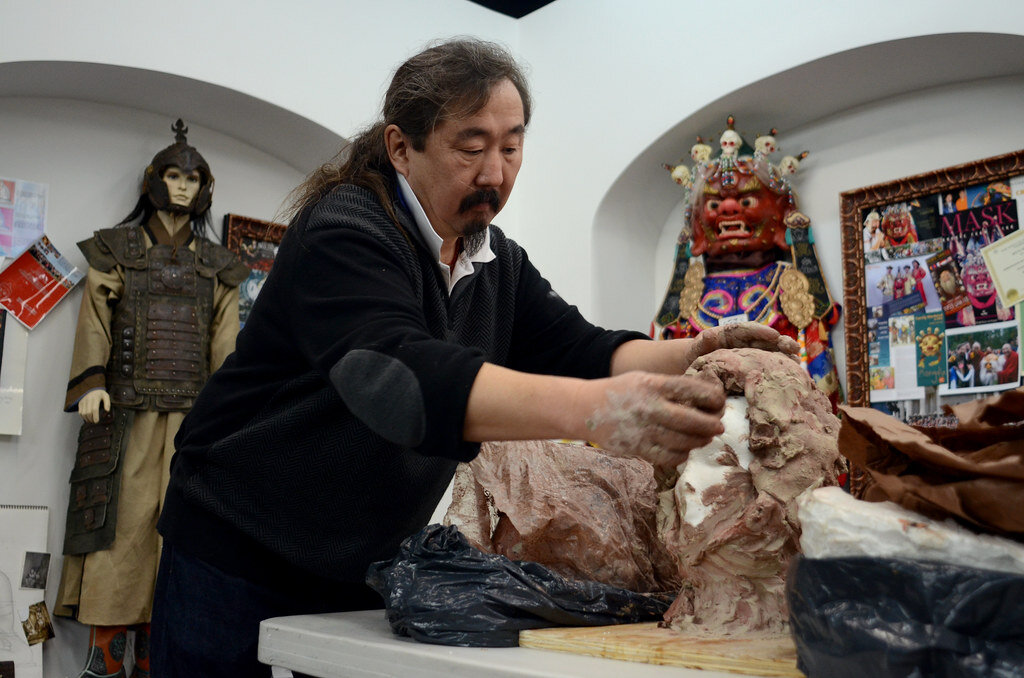Since it first arrived in Richmond as the National Folk Festival in 2005, the Richmond Folk Festival has delighted audiences with a dizzying array of musical traditions from across the nation and the globe. It has also showcased the best of the diverse range of traditional arts from across the Commonwealth through the theme-driven Virginia Folklife Area, combining Virginia’s richly diverse musical traditions with material culture and traditional crafts. In years past, the Virginia Folklife Area has explored such themes as sacred traditions, instrument building, contest traditions, youth and family folklife and many more, bringing together master artisans from the coalfields to the Chesapeake, and from the DC Metro to Danville. This year the Virginia Folklife Area returns with “MASK,” featuring the astonishing Mongolian masks and ceremonial costumes and dance of Arlington, Virginia, resident Gankhuyag “Ganna” Natsag.
Photo: Pat Jarrett
Ganna was born in Ulaanbaatar, Mongolia. Ganna’s parents, famous masters of traditional Mongolian handcrafts, introduced him at an early age to the fine art of making dance masks for the tsam, a Buddhist ritual performed by dancers wearing elaborate costumes and masks. It was introduced to Mongolia in the eighth century, when the Indian saint Lovon Badamjunai sanctified the first Tibetan Buddhist temple. The tsam is a secret and subtle ritual, the meaning of which is often known only to those who perform it. In the 1930s, the Communist government in Mongolia banned the tsam, along with other religious displays. Nearly all but 30 of the original 108 traditional masks and other important ritual objects of the tsam had been destroyed and feared to have been lost forever, until Ganna made it his lifelong mission to research and ultimately recreate each one.
For 10 years, he researched the history of the tsam masks. He spent another decade constructing them using the traditional papier-mâché technique and traditional materials such as animal bone, skin, tails and fur. In 2002, he immigrated to the United States and years later triumphantly returned to Mongolia to stage the full 108-mask cast in Chinggis Khaan Square in Ulaanbaatar, with Mongolia’s prime minister in attendance. He would later stage this grand ceremony for the Dalai Lama.
Ganna now lives in Arlington, where he helps to keep the tsam tradition alive in the city’s growing Mongolian community. Ganna is a prolific artist whose ritual masks and costumes have been exhibited all over the world. He recently helped curate the exhibition Genghis Khan: Bring the Legend to Life which has toured the US and the world. Ganna dreams of one day creating a World Peace Pagoda in Mongolia and has met with the Dalai Lama twice to receive his support for the project. Most recently, the Mongolian government honored Ganna with the title of Cultural Ambassador to the United States for his lifelong dedication to promoting and preserving Mongolian arts and culture.
Photo Pat Jarrett
Masks are often thought of as purely celebratory in nature—a means of adorning new personas for the day, briefly living out our fantasies, making spectacles of ourselves, or perhaps disappearing unnoticed. Yet masks can also carry with them the powerful potential for communities to expressively articulate their deepest values and aesthetics, carry out their most sacred rituals, playfully challenge previously accepted truths and power structures, reify and perpetuate their own cultural identities, and reconnect and reinvigorate their beloved connections to home in new, unfamiliar lands.
And as we have all come to learn over the past year, masks are invaluable as a means of protection, both for our bodies, and as Ganna and the remarkable dancers and musicians he will bring with him make clear, our spirits. Ganna has passed on his love for the tradition of mask making and the accompanying dance to his children, Zanabazar (Zana) and Maral Gankhuyag. Both Zana, Maral, and a host of other dancers, models and musicians will join Ganna in transforming the 2021 Virginia Folklife Area into his personal canvas – the first time that the area will dedicate itself completely to the work of a single artist.
Photo: Pat Jarrett
“Ganna is simply one of the most prolific and impactful artists I have ever encountered,” says Jon Lohman, former Virginia State Folklorist and longtime producer of the Virginia Folklife Area, “and as we gather together again after our year away ‘Mask’ felt like a wonderfully appropriate theme.” MASK will showcase dance performances, mask-making demonstrations, traditional music, and workshops throughout the weekend.





